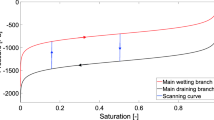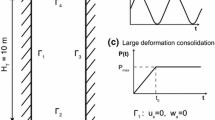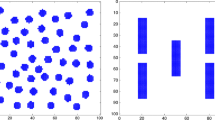Abstract
We investigate shear band initiation and propagation in fully saturated porous media by means of a combination of strong discontinuities (discontinuities in the displacement field) and XFEM. As a constitutive behavior of the solid phase, a Drucker–Prager model is used within a framework of non-associated plasticity to account for dilation of the sample. Strong discontinuities circumvent the difficulties which appear when trying to model shear band formation in the context of classical nonlinear continuum mechanics and when trying to resolve them with classical numerical methods like the finite element method. XFEM, on the other hand, is well suited to deal with problems where a discontinuity propagates, without the need of remeshing. The numerical results are confirmed by the application of Hill’s second-order work criterion which allows to evaluate the material point instability not only locally but also for the whole domain.

























Similar content being viewed by others
References
Agathos K, Ventura G, Chatzi E, Bordas (2017) Stable 3D XFEM/vector level sets for non-planar 3D crack propagation and comparison of enrichment schemes. Int J Numer Methods Eng 113(2):252–276
Armero F, Linder C (2008) New finite elements with embedded strong discontinuities in the finite deformation range. Comput Methods Appl Mech Eng 197(33–40):3138–3170
Borja R, Regueiro R (2001) Strain localization in frictional materials exhibiting displacement jumps. Comput Methods Appl Mech Eng 190(20–21):2555–2580
Callari C, Armero F (2002) Finite element methods for the analysis of strong discontinuities in coupled poro-plastic media. Comput Methods Appl Mech Eng 191(39–40):4371–4400
Callari C, Armero F, Abati A (2010) Strong discontinuities in partially saturated poroplastic solids. Comput Methods Appl Mech Eng 199:1513–1535
Daneshyar A, Mohammadi S (2013) Strong tangential discontinuity modeling of shear bands using the extended finite element method. Comput Mech 52(5):1023–1038
Daouadji A, Darve F, Al Gali H et al (2011) Diffuse failure in geomaterials: experiments, theory and modelling. Int J Numer Anal Methods Geomech 35:1731–1773
Darve F (1994) Stability and uniqueness in geomaterials constitutive modelling. In: Chambon R, Desrues J, Vardoulakis I (eds) Localisation and bifurcation theory for soils and rocks. A.A. Balkema, Rotterdam, pp 73–88
Darve F, Servant G, Laouafa F, Khoa HDV (2004) Failure in geomaterials: continuous and discrete analyses. Comput Methods Appl Mech Eng 193:3057–3085
de Souza Neto E, Peric D, Owen D (2008) Computational methods for plasticity theory and application. Wiley, Hoboken
Di Prisco C, Imposimato S (2003) Nonlocal numerical analyses of strain localisation in dense sand. Math Comput Model 37(5–6):497–506
Ehlers W, Volk W (1999) Localization phenomena in liquid-saturated and empty porous solids. Transp Porous Media 34(1–3):159–177
Hill R (1958) A general theory of uniqueness and stability in elastic-plastic solids. J Mech Phys Solids 6:239–249
Irzal F, Remmers J, Huyghe J, de Borst R (2013) A large deformation formulation for fluid flow in a progressively fracturing porous material. Comput Methods Appl Mech Eng 256:29–37
Kakogiannou E, Sanavia L, Nicot F, Darve F, Schrefler B (2016) A porous media finite element approach for soil instability including the second-order work criterion. Acta Geotech 11:805–825
Khoei A, Karimi K (2008) An enriched-FEM model for simulation of localization phenomenon in Cosserat continuum theory. Comput Mater Sci 44(2):733–749
Laouafa F, Darve F (2002) Modelling of slope failure by a material instability mechanism. Comput Geotech 29:301–325
Larsson J, Larsson R (2000) Finite element analysis of localization of deformation and fluid pressure in an elastoplastic porous medium. Int J Solids Struct 37(48–50):7231–7257
Lewis RW, Schrefler BA (1998) The finite element method in the static and dynamic deformation and consolidation of porous media. Wiley, Chichester
Lignon S, Laouafa F, Prunier F et al (2009) Hydro-mechanical modelling of landslides with a material instability criterion. Geotechnique 59:513–524
Liu X, Cheng XH, Scarpas A, Blaauwendraad J (2005) Numerical modelling of nonlinear response of soil. Part 1: constitutive model. Int J Solids Struct 42(7):1849–1881
Mikaeili E, Liu P (2018) Numerical modeling of shear band propagation in dilatant porous plastic materials by XFEM. Theor Appl Fract Mech 95:164–176
Moes N, Belytschko T (2002) Extended finite element method for cohesive crack growth. Eng Fract Mech 69(7):813–833
Mohammadnejad T, Andrade J (2016) Numerical modeling of hydraulic fracture propagation, closure and reopening using XFEM with application to in situ stress estimation. Int J Numer Anal Methods Geomech 40(15):2033–2060
Mokni M (1992) Relations entre deformations en masse et deformations localisees dans les matériaux granulaires. In: Ph. D. thesis, Grenoble France
Nguyen Vinh Phu, Lian Haojie, Rabczuk Timon, Bordas S (2017) Modelling hydraulic fractures in porous media using flow cohesive interface elements. Eng Geol 225:68–82
Nicot F, Daouadji A, Laouafa F (2011) Second-order work, kinetic energy and diffuse failure in granular materials. Granul Matter 13:19–28
Oliver J (1995) Continuum modelling of strong discontinuities in solid mechanics using damage models. Comput Mech 17(1–2):49–61
Prevost J, Sukumar N (2016) Faults simulation for three-dimensional reservoirs-geomechanical models with the extended finite element method. J Mech Phys Solids 86:1–18
Rabczuk T, Samaniego E (2008) Discontinuous modelling of shear bands using adaptive meshfree methods. Comput Methods Appl Mech Eng 197:641–658
Rabczuk T, Areias P, Belytschko T (2007) A simplified mesh-free method for shear bands with cohesive surfaces. Int J Numer Methods Eng 69:993–1021
Regueiro R, Borja R (2001) Plane strain finite element analysis of pressure sensitive plasticity with strong discontinuity. Int J Solids Struct 38(21):3647–3672
Rudnicki J, Rice J (1975) Conditions for the localization of deformation in pressure-sensitive dilatant materials. J Mech Phys Solids 23(6):371–394
Schrefler B, Sanavia L, Majorana C (1996) A multiphase medium model for localization and post-localization simulation in geomaterials. Mech Cohes Frict Mater 1(1):95–114
Schrefler BA, Secchi S, Simoni L (2006) On adaptive refinement techniques in multi-field problems including cohesive fracture. Comput Methods Appl Mech Eng 195:444–461
Shuttle D, Smith I (1991) Localization in presence of excess pore water pressure. Comput Geotech 9(1–2):87–99
Simo J, Oliver J, Armero F (1993) An analysis of strong discontinuities induced by strain-softening in rate-independent inelastic solids. Comput Mech 12(5):277–296
Steinmann P (1999) A finite element formulation for strong discontinuities in fluid-saturated porous media. Mech Cohes Frict Mater 4(2):133–152
Sukumar N, Prevost J (2003) Modeling quasi-static crack growth with the extended finite element method Part I: computer implementation. Int J Solids Struct 40(26):7513–7537
Wang Y, Waisman H (2017) Material-dependent crack-tip enrichment functions in XFEM for modeling interfacial cracks in bimaterials. Int J Numer Methods Eng 112(11):1495–1518
Wells G, Sluys L (2001) A new method for modelling cohesive cracks using finite elements. Int J Numer Methods Eng 50(12):2667–2682
Zhang H, Schrefler B (2000) Gradient-dependent plasticity model and dynamic strain localization analysis of saturated and partially saturated porous media: one dimensional model. Eur J Mech A Solids 19(3):503–524
Zhang HW, Sanavia L, Schrefler B (1999) An internal length scale in dynamic strain localization of multiphase porous media. Mech Cohes Frict Mater 4(5):443–460
Zienkiewicz OC, Chan A, Pastor M, Schrefler B, Shiomi T (1999) Computational geomechanics with special reference to earthquake engineering. Wiley, Hoboken
Acknowledgements
Ehsan Mikaeili acknowledges the Sharif University of Technology, department of civil engineering for the general assistance and consultation. B. A. Schrefler acknowledges the support of the Technische Universität München—Institute for Advanced Study, funded by the German Excellence Initiative and the European Union Seventh Framework Program under Grant Agreement No 291763.
Author information
Authors and Affiliations
Corresponding author
Additional information
Publisher's Note
Springer Nature remains neutral with regard to jurisdictional claims in published maps and institutional affiliations.
Rights and permissions
About this article
Cite this article
Mikaeili, E., Schrefler, B. XFEM, strong discontinuities and second-order work in shear band modeling of saturated porous media. Acta Geotech. 13, 1249–1264 (2018). https://doi.org/10.1007/s11440-018-0734-6
Received:
Accepted:
Published:
Issue Date:
DOI: https://doi.org/10.1007/s11440-018-0734-6




